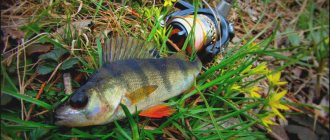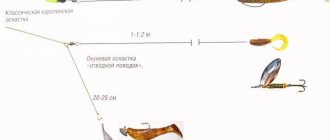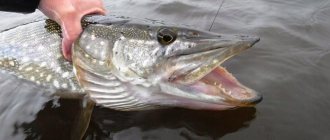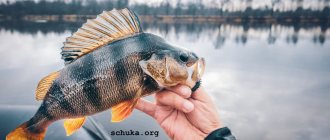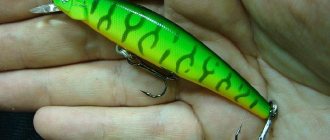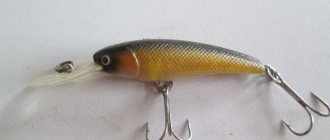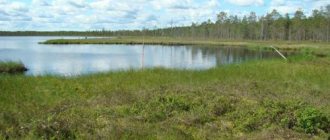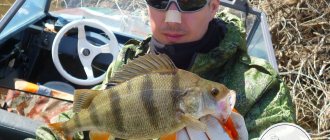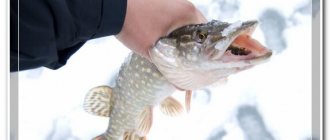When does perch go to spawn?
Perch is a fish that avid fishermen love to hunt.
Fish are found everywhere and love exceptionally clean water. As soon as the water temperature reaches +9 degrees, you can expect a decrease in perch activity, which means the fish have gone to their spawning grounds. Perch spawning starts in March-April. Due to unfavorable weather conditions, perch often starts spawning in mid-May. It all depends on the specific region and climate zone. The fish go to the spawning grounds at sunrise. During this romantic period, the perch changes color to a more saturated one.
From the shore you can see the fish rubbing against stones or reeds. This is especially noticeable in the early morning. But large individuals are accustomed to spawning at depth, huddled in schools.
Conditions for spawning of perch
Content
Perch spawning begins at different times of the year and directly depends on a number of conditions: oxygen concentration, water temperature, and the availability of suitable places.
Important! Popular spring fishing for perch using a spinning rod during spawning is prohibited, but shows good results before and after spawning. During the feast, large specimens are often caught, and the catch promises to be the most abundant. The bite completely disappears when the water temperature reaches 8°C.
The spawning of perch depends on the water temperature, since the predator itself loves low temperatures; to start spawning, it is enough for it to warm up the water to 7-10°C. Rivers usually warm up faster, so initially the river predator goes to the spawning grounds. In lakes with stagnant water, where there is no current, spawning is delayed and lasts longer, because the water retains ice cover longer. A predator will never spawn under ice, because the second important condition for the start of spawning is a high concentration of oxygen in the water.
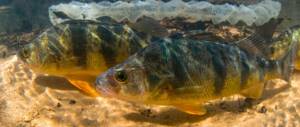
Perch spawning depends on water temperature
Interesting Facts! Spawning lasts from several days to a week, now single specimens that have an unusually bright color may be caught - this is the normal state of the predator. You can often visually see the perch rubbing against roots, stones or dried vegetation near the shore.
Before spawning, perch gathers in large or small groups, but large-sized individuals do not like to stay in a school, preferring to be at depth in the reservoir. In trophy perches, spawning occurs at depth and cannot be observed at the surface. Usually small perch go to spawn earlier than large ones.
How does perch behave during spawning?
Perch is accustomed to approaching spawning sites several weeks in advance. Grass fish gather in schools (100 each), while large humpbacks love solitude and gather in schools of 10 individuals. During the spawning period, the outfit of the perch changes - the stripes become brighter, the scales acquire an emerald hue, and the fins become red.
Perch breeding occurs in silence, without unnecessary sounds or active movements. In shallow waters, striped backs can be seen. Females prefer secluded places with dense ribbon-like vegetation to spawn. Fish spawn for almost half a month. Sometimes weather conditions affect spawning and its duration increases.
Spawning process
Despite its constant mobility and activity, during spawning the perch behaves quietly, rarely showing its presence. It is difficult to visually determine where the striped robber lays its offspring, since it does not give itself away by noise at the surface of the water. Large individuals are completely secretive, since for them this process occurs at medium depths. Important! In many reservoirs there is a spawning ban at this time, so fishing is prohibited! Fishing is permitted only in certain areas, a list of which is published in fisheries protection orders. Perch usually spawns in the morning or evening hours. On sunny days this happens from the very time the sun rises and during its sunset. In cloudy weather, the spawning hours may shift closer to the middle of daylight, but the striped one still sticks to the dawn. Perch becomes sexually mature at three to four years of age. In some reservoirs, where there is a rich food supply and this type of predator is dominant, the striped robber can begin to spawn at the age of two years. The female perch is very fertile. An individual measuring approximately 200 grams per spawning is capable of laying from 200 to 300 thousand eggs, and larger specimens even more. Naturally, not all of the offspring will survive, and the majority will be eaten by waterfowl and underwater inhabitants, such as roach, crucian carp, goby, silver bream and others. The spawning process for perch lasts about two to three weeks. During this time, the female striped robber lays eggs in two, less often in three, stages. The masonry itself is a light ribbon of eggs glued together, up to one and a half meters long. It has a cellular structure and attaches to submerged branches, vegetation and other irregularities on the bottom.
When does perch spawn in central Russia?
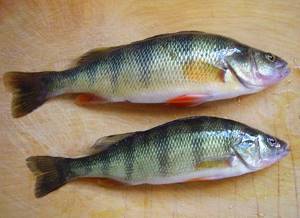
Comfortable temperature is a must for successful spawning. Since even in central Russia the weather has been unstable lately, it is quite difficult to predict the spawning of perch. Most often, spawning occurs at a temperature of 10–12 degrees.
Perch goes to spawn when the ice melts, since the water must be sufficiently saturated with oxygen. Remember that spawning times are different for deep-sea fish and grass fish. The fact is that each of these species chooses different places to lay their offspring. Deep-sea inhabitants rarely appear in shallow water in the spring.
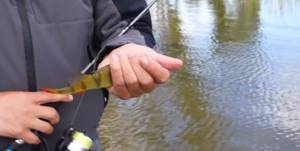
Where does perch like to spawn?
Small or grassy perch are accustomed to spawning at a depth of no more than a meter, while larger individuals try to stay in deeper waters - at least one and a half meters.
Perches await special conditions to produce offspring:
- The flow should be completely absent or minimal. Fast currents can wash away the eggs. Perches love to spawn in calm bays that have virtually no current, but are abundant in vegetation, which the fish like so much.
- Perches prefer underwater obstacles in the form of sunken logs and tree branches. When there is no vegetation in a reservoir at a depth comfortable for perch, the fish have to look for places with underwater obstacles.
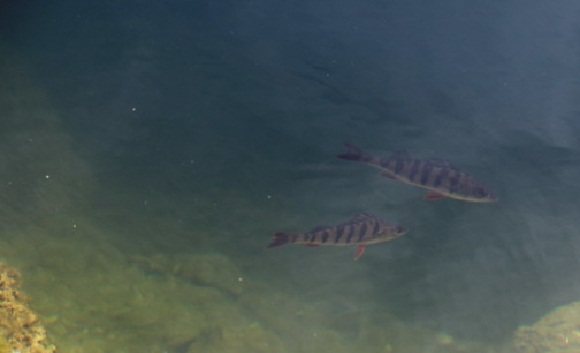
- The water must be enriched with oxygen. If the reservoir does not meet these qualities, there is a high chance that the eggs will die.
In search of a suitable place, perch can migrate through a reservoir for a long time, usually upstream. Having found a suitable place, the perch will return there again and again.
The female is capable of laying up to 200,000 eggs at a time, which indicates the high fertility of the fish. Nevertheless, some of the eggs are eaten by the perch itself and other predatory inhabitants, so the survival rate of the fish is reduced to a minimum at the very beginning of life.
In the warm season, perches are usually seen in small schools, several dozen, rarely hundreds of pieces, and then small, one-year-olds, but in the spring, before spawning and especially at the end of autumn, they gather in huge schools, which consist of fish of the same age and are even more numerous , the smaller they are, so the largest schools occur in the fall and consist of fingerlings and one-and-a-half-year-old perches.Judging by the fact that they are caught in large numbers almost all winter with seines and fishing rods, it must be assumed that these flocks are divided into smaller ones only in early spring.
In general, perch is a sedentary fish, never travels long distances, even before spawning, and often, as, for example, in ponds and lakes, lives all year round in the same place.
This is noticed, for example, in those Trans-Ural lakes in which fish are caught not only in autumn, but also in spring, even in summer: at any time, in the deep kuryas (bays) of these lakes, huge perches are noticed, the hard scales of which cannot be penetrated by any spear, why don't fishermen even hit them.
Large perch is a very agile, strong and predatory fish. One must be amazed at the greed and tenacity with which he chases up some fish that he has separated from the school. The unfortunate fish jumps out of the water like crazy, and the perch circles behind it, opening its huge mouth with a loud slurping sound until it grabs it.
The chomping sound of a large perch is so loud that in calm weather you can hear it a hundred paces away.
Small perches are not inferior to large ones in their agility and agility of movements.
Who hasn’t seen how schools of perch hunt for fry, that is, the young of other fish; it even happens that, carried away by the pursuit, they run aground after their prey, even onto the coastal sand.
Perches swim very quickly, but in jerks, often stopping suddenly and then rushing forward again. The perch does not allow any living creature to escape, from small aquatic insects to fairly large fish, as long as it is within its strength and can fit in its wide mouth.
It itself is relatively rarely eaten by other predatory fish, which do not like its sharp dorsal spines.
The main food of perch is small fish, also caviar; The large one is very fond of crayfish and during the molting of the latter it stays near stones, snags, under the shore - in a word, near crayfish holes.
Small crustaceans from the genus amphipods make up a very tasty food for this fish. In the Trans-Ural lakes, the so-called mormysh, apparently, is the main food of perches from October to December and in February and March.
This explains why in lakes abounding in jigs, perch grows extremely quickly and reaches enormous sizes.
Perch spawning.
Sexual maturity usually occurs in the third year, very rarely, only in the most feeding lakes, to which many lakes of the Trans-Ural Territory belong, - in the 2nd year.
Here you can find one-and-a-half-year-old perches weighing up to 1/2 pound, but in rivers this fish grows much slower, and perches that hatched almost two years ago rarely reach 3 inches in length (from the end of the nose to the end of the tail) and almost always throw next, i.e. third, spring.
The spawning time of perch varies depending on the latitude of the area.
In general, the spawning of perch depends on the time of the final opening of the waters: in ponds and lakes it never “rubs” the previously complete disappearance of ice, and only in the lower reaches of large rivers flowing to the south does it finish spawning before the water begins to arrive and the ice flows from the upper reaches.
In Central Russia, river perch usually spawns when the water subsides, primarily in small rivers. In semi-flowing ponds, that is, those that flow only in the spring and after heavy rains, spawning begins several days later than in rivers, and in stagnant lakes it slows down even more.
Thus, in the same area, the difference in spawning time can be more than a week, sometimes ten days.
This phenomenon is explained by the fact that each breed of fish does not spawn before the water reaches a certain temperature at which the development of eggs of one or another breed becomes possible.
This temperature varies for different fish, and perch apparently spawns when the water reaches 7 or 8 degrees Celsius.
In general, here, near Moscow, the beginning of perch spawning in rivers and rivers coincides with the beginning of birch tree blossoming, and the latest spawning occurs in early May, when the leaf has already fully unfurled.
Many other fish spawn before perch: dace, pike, ide; only in the lower reaches of the Volga, perch, according to Yakovlev’s observations, spawns earlier than all other fish - in March, immediately after the mouths are opened from the ice.
Schools of perch leave their winter camps - holes, as soon as small edges are formed, i.e., at the first arrival of water, they are divided into smaller camps and approach the shores.
Often, from large rivers or lakes of the village, these enter tributaries that have been cleared of ice, walk for some time along the floods of these rivers, chasing small fish here and eating the eggs of dace, pike and ide, never, however, going far upstream.
Such flocks usually spawn here and return back to the river when it has already entered the banks. Most of the perches in large rivers spawn, however, in oxbow lakes and flood lakes, where the flood drives them; when the waters quickly recede, they sometimes remain here until the next spring or a major flood.
In the lower reaches of the Volga, most perches work in remote eriks and ilmens, which do not have any communication with the riverbed during spawning (before the flood), and can leave here only much later.
Schools that have wintered in river holes and on the seashore (in those parts of the Caspian Sea where fresh water does not predominate, perch do not live) come to spawn in the first ilmens and kultuks that come across, i.e. river and sea bays.
The number of spring schools of perch almost always depends on the age of the fish and its abundance. The largest schools of perch are young, usually two-year-old, almost three-inches long (counting from the nose to the end of the tail); the largest individuals rub together in small families.
In rivers, however, spring camps of perch are always much smaller in number than in large flowing ponds or lakes, especially those where perch is almost the main species of fish.
In the latter, small perch spawn in huge herds of several thousand, although it may very well be that this number of schools is only apparent and each school consists of many separate villages gathered in one place convenient for spawning.
Otherwise, it is very difficult to explain why in the eriks and ilmens of the Volga estuaries, where perch is also found in abundance, it, as V.E. Yakovlev testifies, spawns “not in schools, but alone, in separate pairs or small flocks.”
This may only be true where perch are very rare. According to my observations, there are significantly fewer molosniks than egg-birds, but no difference was noticed in the growth of males and females. It seems that large perch spawn a little later than small ones (by several days), but I cannot confirm this; it is very likely that large individuals wintering in the deepest holes come out to shallow, warmer water later than the small ones that become closer to the shore.
Spawning in rivers almost always takes place in places that have no current or only a weak one, certainly in places where perches can find objects that they can rub against and thus contribute to the rapid flow of eggs and milt.
These items vary depending on the nature of the area. In ponds and lakes, perches rub in old, broken reeds and reeds, in shallow places, and, in the absence of the above-mentioned plants, on the remaining stems and roots of burdock (water lilies); in rivers, eggs are spawned in creeks or bays, also on the stems of aquatic plants or on driftwood, various rubbish, on the roots of trees washed away by water, sometimes on the branches of flooded bushes; in large rivers, perch mostly rubs in oxbow lakes and flood lakes, also in grasses.
Only in northern and northwestern lakes (partly rivers) with rocky beds does perch spawn on stones and sometimes on sand.
It has been noticed that large perches always rub in deeper places than small ones, and most willingly drop their eggs on old sunken stems of aquatic plants. During spawning, for the same reasons, perches go well into muzzles and tops woven from willow twigs, and they can easily be attracted to any place by placing several pine trees or fir trees there.
Like most fish, perch become more vibrantly colored shortly before spawning.
The proximity of this time can always be determined several days or a week in advance by the redder fins and sharply prominent stripes on the back.
Perches with mature reproductive products are therefore very different from young perches from last year and third year, which are always paler and almost the same color.
In most cases, these perches follow the schools of spawning fish in masses and diligently eat the eggs they have spawned.
The spawning itself takes place relatively more calmly than, for example, with roach, dace, bream and some other carp fish, which spawn in large herds.
The spawning of large perches is not even noticeable, partly because their schools are small, partly because they rub at greater depths than small ones - between deep-seated reeds or (in some lakes) between stones.
But small perch, at least in the so-called perch lakes, spawning in large runes (which are joined by even larger schools of juvenile perch) and in shallow water, often jump out of the water, and sometimes even gather in lake bays in such numbers that the upper rows , protruding outward at the bottom, produce a strong splash, audible and visible from afar.
The best indicator of spawning grounds and a large concentration of fish in general is, as almost always, the presence of gulls, loons and other water birds.
Perch spawns exclusively early in the morning, sometimes shortly before sunset; in the midday heat and in the evening the game weakens significantly, the school thins out for a while, and at night the agitated fish completely calms down.
Each fleece for the most part completes spawning in two or three stages, i.e. in the morning and evening or at two in the morning and evening, but the game of perch of all ages continues for a very significant time - about a week, and spawning is apparently completed by the largest perches.
The eggs of this fish are very numerous: in a half-pound perch there are from 200 to 300,000 eggs, and in large ones - much more.
A very characteristic feature of perch caviar is the fact that it is produced in long, two-, sometimes three-arshine, gelatinous ribbons, in which individual eggs, the size of a poppy seed, lie in small piles (from 3-5 eggs), and each such pile is enclosed in a special gelatinous cell, which makes the entire tape look like a narrow network.
Upon exiting these ribbons roll up into irregular balls and are usually attached to underwater plants or float freely on the surface.
Some German authors claim that the female, accompanied by the male, looks for a twig, a broken stem of an underwater plant, and first of all tries to glue the beginning of her tape to this twig, for which purpose she sits on it for a while, so to speak, with her anus; Having secured the ribbon, the female begins to swim in zigzags and releases her reel, watered with the male’s milk.
It is very possible that spawning occurs in this way and in pairs, but nevertheless there is no doubt that in some places perches gather in large flocks to spawn.
In many areas of Russia (for example, on the Dnieper and in the northwestern lakes), fishermen collect this caviar at spawning sites and cook it like porridge or use it as a filling for pies. Even more eggs are, of course, consumed by water birds and eaten by fish.
This partly explains why, with such a mass of eggs released by each female, perches in some places are not nearly as numerous as one would expect.
But, in addition, perch eggs are subject to many more accidents, and the “harvest” of juveniles, almost more than that of other fish, depends on atmospheric influences - temperature and especially winds.
Since perch spawns quite early, in shallow places and even releases eggs to the surface of the water, one strong morning storm can destroy almost all the eggs and half-developed embryos.
Prohibitions during perch spawning
During the spawning period, the perch's fat intake is reduced to a minimum. Nature has endowed the fish with a protective mechanism that prevents the perch from devouring its own eggs. There is no ban on catching perch during the spawning period. You can catch it successfully, despite its low activity. The fact is that fish spawn periodically. Some flocks have brought spawning to an end, others are just starting to spawn, while others have already returned to their spawning grounds and are starting active feeding.
Fishermen have every chance of catching perch, because during the spawning season, fish migrate through reservoirs in schools. You can fish with a half-bottom, a fishing rod or a spinning rod. Vibrating tail, silicone baits or twisters will work as bait. But the best baits were and remain worms.
Finding a place to catch perch
Experienced fishermen say that catching perch with a spinning rod in September tests the angler’s observation skills. Before casting a spinning rod, you need to determine the place where the perch hunts.
If you look closely, in some places:
- close to the shore,
- near the coastal reeds
a burst of fry is noticeable. This is a sure sign that a predatory perch is out hunting. But you should not cast the fishing rod into the very center of the circle, but slightly to the side.
You can also look for fish in the following places:
- on the reaches;
- in standing pools;
- in bays overgrown with reeds.
When does perch start biting after spawning?
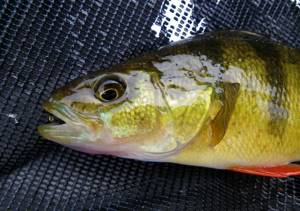
Each region has its own fish spawning season. The further north the region, the later the spawning will end. In the north, spawning comes to an end in May-June, in central Russia - in April-May, in the south - in April. It is difficult to determine specific spawning dates, so an experienced angler will first test the waters. If the fish bites sluggishly, it means that the perch has just started spawning.
After catching a couple of fish, feel the belly for caviar. During the spawning period, the belly is dense, enlarged, and the presence of caviar is felt. After spawning, the belly will be soft to the touch. So, you will understand at what stage of spawning the female is.
The spawning will last for several days. During this period, the fish will be extremely inactive. But after having offspring, a wild zhor will awaken in the perch, lasting several weeks. At this time, catch a trophy specimen weighing up to 1 kg. as easy as pie.

Tips from Velesovik
Remember that perch will not go to spawn while the reservoirs are covered with ice.
When going perch hunting, use jigs, edible rubber baits, and bright artificial baits. Rotating spinners have proven themselves to be quite good. The main thing is not to stop experimenting. The size of baits must be at least 5 and no more than 8 cm, and the colors can be very diverse.
Silicone baits can attract not only perch, but also pike perch and pike perch, so be careful, as the spawning ban on catching pike and pike perch is stricter.
Striped predators are not averse to feasting on foreign eggs and newly “hatched” fry, so don’t be shy about conquering new depths.
Can you catch perch on the track?
The path is convenient to use for scouting perch sites; Having caught the first perch in the lane, the boat is anchored and fishing continues with a spinning rod or other method.
When fishing on the track, use the same light rotating spoons as when fishing with a spinning rod in deep, quiet places. Just as with spinning fishing, it is very important to select the weight of the sinker so that the spoon always goes to the desired depth.
Catching perch using vertical lures has become widespread.
Perch is a relatively strong fish. Once hooked, it makes sharp throws to the side, trying to go into grassy thickets or snags. However, fishing for perch on strong tackle does not present any particular difficulties; you just shouldn’t drag it straight through, which can lead to the breakage of the perch’s weak lip.
Share link:
- Click to share on Twitter (Opens in new window)
- Click here to share content on Facebook. (Opens in a new window)
- Click to print (Opens in new window)
- Click to share on LinkedIn (Opens in new window)
- Click to share on Telegram (Opens in new window)
- Click to share on WhatsApp (Opens in new window)
- Click to share on Skype (Opens in new window)
- Send this to a friend (Opens in new window)
